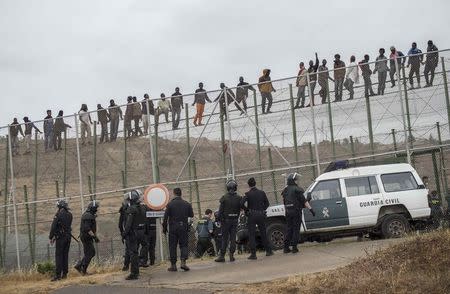Hundreds of migrants storm across Spanish border at Melilla

MADRID (Reuters) - More than 1,000 would-be immigrants tried to forced their way over razor-wire barriers into Spain's North African enclave of Melilla on Wednesday, with about half succeeding. The Spanish government said about 500 people managed to breach the border between the enclave, which is officially part of Spain, and the Moroccan territory that touches it along with the Mediterranean sea. Immigrants from all over Africa regularly attempt to cross the fences at Melilla and a second Spanish enclave along the coast, Ceuta. Spain has beefed up security in the enclaves in recent months as the numbers seeking to enter have swelled, in part response to increased naval patrols that are discouraging attempts to get to Europe by boat. "There were waves (of people), they were difficult to stop," the enclave city's mayor Juan Jose Imbroda said in a radio interview. "Moroccan police collaborated quite a bit, but the pressure was great, a chunk of the exterior fence gave way." Video footage from the Guardia Civil, the Spanish gendarmerie, and distributed by the government showed dozens of people clambering over a point in the tall wire fencing that had half collapsed. In March about 500 people forced their way across the Melilla border, and around 2,000 have breached the 12-kilometre barriers so far this year, up from just over 1,000 for the whole of 2013. The immigrants who got into Melilla on Wednesday were heading for the city's temporary migration centre, where they are usually fed and given clothes before Spain tries to work out whether they can be repatriated or can stay in the country. The centre is designed to take in 500 people but is already sheltering about 2,000. Many of those housed there often make it to continental Spain if migrants successfully claim asylum or if authorities cannot establish their nationalities. Spain has also been accused in local media of trying to return migrants to Morocco without processing them, something the government has denied. Both Spain and Italy have attempted to persuade their northern European neighbours to bear a greater share of the increasing immigration burden, but talks on an EU-wide solution to the problem have made little progress. Last October more than 360 people drowned within sight of Lampedusa, an Italian island off Tunisia that has long been a magnet for migrants, and in May a migrant boat sank in the sea between Libya and Southern Sicily, causing at least 14 deaths. In February, the European Union asked Spain to explain why police had fired rubber bullets in warning when a group of African migrants tried to wade and swim to Ceuta. Fifteen drowned. Spain has said the migrants were not targeted by the shots. Deputy Interior Minister Francisco Javier Calderon said the government would send 100 additional security forces to the city and build up a new barrier that make it impossible for the migrants to jump over it. (Reporting by Teresa Larraz, Writing by Sarah White, Editing by Julien Toyer and Jeremy Gaunt)

